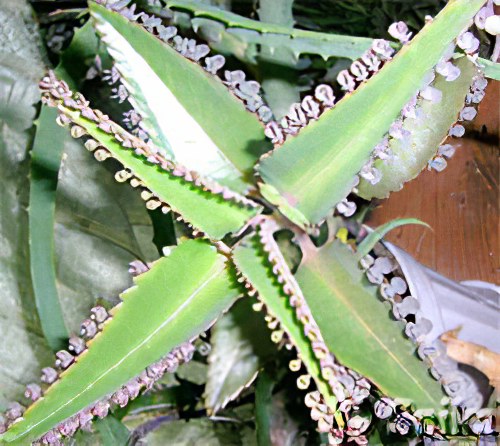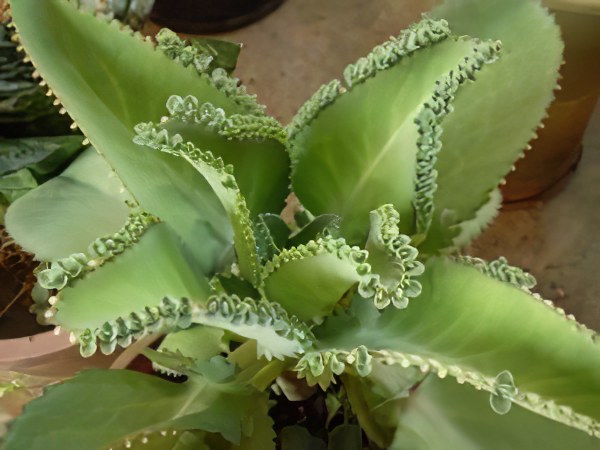Botanical characteristics of Kalanchoe

Kalanchoe is a succulent perennial plant that is green at any time of the year. The plant belongs to the jumbo family, has shoots with beautiful dense foliage. On the erect stems of the Kalanchoe are large leaves located opposite each other. In this plant, the serrated leaves have different colors depending on the location on the stem, for example, they are bright green at the top, and the lower leaves are gray-green with a purple tint.
The flowers of the plant are pale green in color with a pinkish tinge, collected in panicle inflorescences. The flowers of this plant have unusual petals, as they are triangular in shape and brick-red in color. The Kalanchoe fruit is a multi-seeded leaflet. Kalanchoe blooms irregularly, but there are also years when the plant is strewn with beautiful flowers.
In the wild, Kalanchoe grows only in Africa and on the islands located next to it. Also, this medicinal plant can be seen in Madagascar on rocky slopes. Kalanchoe is often grown in a residential area, not only as an ornamental, but also as a medicinal plant.
Useful properties of Kalanchoe
Kalanchoe has anti-inflammatory, hemostatic, bactericidal properties. In addition, Kalanchoe is a remedy used to heal various wounds. Fresh plant sap contains many useful substances, such as tannins, enzymes, flavonoids, organic acids, micro- and macroelements. Due to the content of a large amount of nutrients in the juice of the plant, it is used for ulcers, purulent wounds, tissue necrosis, boils, burns , bleeding and erosion of the cervix.
Kalanchoe relieves acne, rashes and blemishes on the skin of the face. Kalanchoe-based preparations can help in the treatment of eye diseases. If Kalanchoe is grown in a dark and cool room, then a mass of biogenic stimulants accumulates in it, which help in the treatment of various diseases.
Growing and caring for Kalanchoe

Kalanchoe is a plant that is undemanding to growing conditions. The place for growing Kalanchoe should be sunny. The plant is propagated by stem or leaf cuttings. Cut cuttings need to be dried for about two days before planting. Until the cuttings take root, they must be watered very carefully. Do not cover the container with cuttings. Some plant species are propagated using seeds. It will take a whole year from the day the seeds are sown to the blooming period. With the method of propagation by cuttings, this period will be much reduced and will be only 2 months. If the flowers of the plant are needed at the end of winter, then the seeds are sown in January, and the cuttings are planted in March.
Care. For the entire period of growth, Kalanchoe needs to be watered, but in moderation. In winter, the plant does not need constant watering. From the last spring days until mid-summer, you need to fertilize with fertilizers. Every year Kalanchoe should be transplanted to a new place. To do this, it is necessary to prepare the soil, namely to mix leaf, turf and peat lands in equal proportions. Sand and brick chips are also added here.
When the flowering of the Kalanchoe ends, all peduncles should be removed. After placing the plant for a month in a dark place, it needs to be watered a little. Then it is transferred to a bright and lighted place, watering as usual.
Kalanchoe application
Kalanchoe is widely used in folk medicine, and it owes this to its numerous medicinal substances and their properties. Kalanchoe tincture, which is rubbed into the skin, improves blood circulation, so there will be no blockage of blood vessels. The leaves of the plant contain organic acids, polysaccharides, which are part of the most active drugs.
Kalanchoe juice for periodontal disease.
To prepare it, you need to cut the plant and hold it for a week at a temperature not exceeding 10 ° C heat. Then, using a wooden spoon, everything is grinded into gruel. After that, taking cheesecloth, squeeze the juice into a bowl and leave it in this position for 2 days - this is necessary for complete precipitation. The finished juice must be diluted with 20% alcohol (20 parts of juice to 1 part of alcohol). This medicine is used for ulcers, purulent wounds, bedsores and fistulas. For these purposes, it is necessary to take several layers of gauze, wet with Kalanchoe juice, and apply to the wound. Kalanchoe juice also helps to reduce bleeding gums or relieve itching . To do this, you need to inhale this juice.
Kalanchoe tincture with alcohol.
Take 1 tablespoon of chopped leaves, pour 100 ml of alcohol (40%) and leave to infuse for 10 days in a warm place. After straining the tincture, it can be used as a lotion or rinsing agent. For example, it can be used to treat otitis media by putting 1 or 2 drops of the tincture into the ear before bed.
Kalanchoe ointment.
To prepare it, you will need to combine 15 ml of Kalanchoe juice and 25 grams of lanolin in a small bowl. Add another 25 grams of petroleum jelly to this mass and mix everything until smooth. This ointment is used in the presence of trophic ulcers and boils.
Kalanchoe tincture for varicose veins in the legs .
Take a half-liter jar and, filling it with plant leaves, finely chopped in advance, pour vodka to the top. Next, you need to tightly close the jar and put it in a dark room for 7 days. The finished tincture should be rubbed on your feet at night, making circular movements with your fingers. You need to start rubbing from the feet, moving up. So it is necessary to be treated for two, or even three months.
Kalanchoe medicine for the prevention of influenza.
Cut off the Kalanchoe leaves and squeeze the juice from them. Taking fresh plant juice, they lubricate the nasal mucosa 3 times a day.
Fresh Kalanchoe juice is used for inflammation of the eyelids, ears, mouth, purulent wounds, burns and other skin diseases.
Kalanchoe leaves, pre-crushed, are used to prepare a compress to destroy warts. Also, the leaves of this medicinal plant are used for mental fatigue. Kalanchoe leaves are enough just to chew a little and swallow - and efficiency will return in a matter of minutes.
Contraindications to the use of Kalanchoe
Kalanchoe is contraindicated for pregnant women and allergy sufferers, but the contraindications to this plant do not end there. People with liver disease, hepatitis and cirrhosis should also not use Kalanchoe medications. It is not recommended to use Kalanchoe for people with tumors or low blood pressure.
Comments
Post a Comment